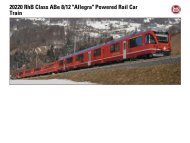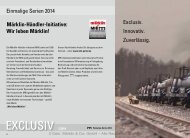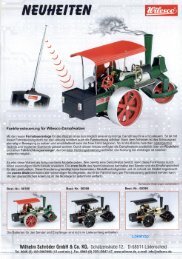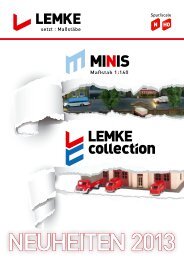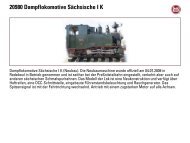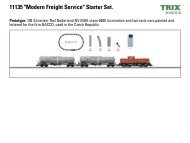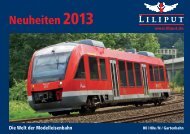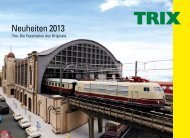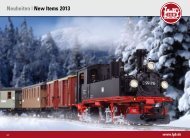Liliput Neuheiten 2012 - Lokshop
Liliput Neuheiten 2012 - Lokshop
Liliput Neuheiten 2012 - Lokshop
Erfolgreiche ePaper selbst erstellen
Machen Sie aus Ihren PDF Publikationen ein blätterbares Flipbook mit unserer einzigartigen Google optimierten e-Paper Software.
Kesselwagen-Set mit Diesellokomotive, Epoche III<br />
Schneepflug, DB, Epoche IV<br />
22<br />
L230119<br />
L230903 Schneepflug, DB, Ep. IV Snow plough, DB, Ep. IV L230904<br />
Bremen 979 4 192-9<br />
Kupplungsaufnahme nach NEM<br />
362, Länge mit Pflug 136 mm.<br />
Zugpackung Kesselwagenzug, Epoche III<br />
Diesellok V 14.03 der Raffinerie Ingolstadt, mit 3 Kesselwagen<br />
der Mineralöl-Gesellschaften „SHELL“, „ARAL“<br />
und „ESSO“<br />
Alle Fahrzeuge mit Kupplungsschacht nach NEM 362, Wagen<br />
mit Kurzkupplungskinematik, Gesamtlänge LüP ca. 400 mm.<br />
Aus frei gewordenen Wannentendern ließ die<br />
Deutsche Bundesbahn in den fünfziger Jahren<br />
mehrere Schneepflüge bauen. Diese waren in<br />
fast allen Direktionsbezirken der DB eingesetzt.<br />
Bremen 979 4 192-9<br />
Coupling shaft as per NEM 362,<br />
length including plough 136 mm.<br />
Tank wagon train set, Epoch III<br />
Diesel loco V 14.03 of the refinery Ingolstadt with 3 tank<br />
wagons of the oil companies “SHELL”, “ARAL” and “ESSO”<br />
All vehicles with coupling shaft as per NEM 362, wagon with<br />
close coupling kinematics, total l.o.b.: approx. 400 mm.<br />
The German Federal Railway had unused tub-style<br />
tenders converted into snow plows in the fifties.<br />
These were in service in almost all administrative<br />
divisions of the German Federal Railway.<br />
Schneepflug, DB, Ep. IV<br />
München 979 4 147-4<br />
Kupplungsaufnahme nach NEM<br />
362, Länge mit Pflug 136 mm.<br />
Snow plough, DB, Ep. IV<br />
Munich 979 4 147-4<br />
Coupling shaft as per NEM 362,<br />
length including plough 136 mm.<br />
To page 23:<br />
Precursors of today's containerised<br />
traffic were the mediumsized<br />
containers, so-called pacontainers.<br />
Directly after the<br />
Second World War the German<br />
State Railways procured 334<br />
three-compartment carrying<br />
wagons and 1,000 medium-sized<br />
containers - each one as an open<br />
and closed construction as well<br />
as pa-containers for water-sensitive<br />
general cargo.<br />
Whereas in the beginning old<br />
chassis types were converted<br />
into carrying wagons, 1952 saw<br />
the new design enter service on<br />
a large scale. Almost 1900 threecompartment<br />
wagons followed<br />
from 1955 onwards with 2400<br />
four-compartment BTms 55 as<br />
well as from 1958 also five-compartment<br />
wagons. At the same<br />
time the containers underwent<br />
further development and special<br />
containers were procured, e.g.<br />
for refrigerated cargo and various<br />
liquids. In particular, containers<br />
for general cargo and for<br />
beer were privately produced by<br />
numerous firms and painted in<br />
the company livery.<br />
The last four-compartment container<br />
carrier wagons of the German<br />
Railways were deployed until<br />
the early eighties. After this<br />
time many chassis of the now<br />
defunct wagons were converted<br />
into railway service coaches, e.g.<br />
for wheel transports. Two hired<br />
wagons, now designated as<br />
Lbms 485, were accepted by German<br />
Railways in 1994.<br />
LILIPUT NEUHEITEN <strong>2012</strong> H0 1:87



